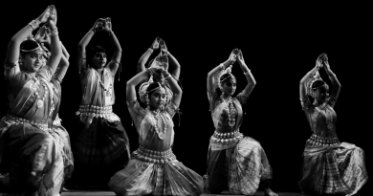
|   |

|   |
Deba Smruti 2016 - Nita Vidyarthi e-mail: nitavidyarthi@gmail.com Photos courtesy: Tridhara June 24, 2016 Tridhara, the renowned institution founded in the eighties by the Late Guru Debaprasad Das in Bhubaneswar, upholds the guru’s unique dance style that has the essence of classical Odissi, folk and tribal traditions. After Guruji, his legacy is carried forward ably by his distinguished disciple Guru Gajendra Panda as the director of the organization by continuing the “parampara” of organizing festivals, seminars and workshops worldwide for the last two decades. ‘Deba Smruti,’ an evening of Odissi dance, is one such endeavour by Tridhara in remembrance of Guru Debaprasad Das, held every year on May 30th, as a culmination of workshops in April at different places of Odisha and outside and a month long workshop from 1st May through 29th May, 4 hours each morning and three hours in the evening in Bhubaneswar. Some of Guru Debaprasad Das’ compositions are presented together with choreographed pieces based on his style. These participants as also others from workshops at different places showcase their aptitudes and abilities on May 30th. Only those who have attended the workshops earlier and belong to the “Debaprasad Parampara” are permitted to join. No new artists can participate. This year was the 30th Deba Smruti and altogether 96 dancers participated, some very young, including those from outside of Odisha, Malaysia, Singapore, Japan, Jharkhand, Chattisgarh, Saranggarh, Raipur and Kolkata. Exceptions were two professional Kathak dancers, Ominish Das from Jamshedpur and a young female dancer Anchal Pandey from Bilaspur, Chattisgarh who were so overwhelmed to see the Guru’s style that they decided to take a leap into Odissi. The evening opened with the invocation Laxminrusingh Dhyana,“Om Gananatha Ganapati Bhabamahe.” Set to raga Mangala Gurjari and Lalita, tala-ektali and Jati tala, the senior group of seven female dancers including Chisato Miura from Japan and the strong male dancer Prabhutosh displayed a good command over the steps doing full justice to the neat choreography and geometric formations. Prabhutosh, with his vigorous movements encircling the stage was convincing as Nrusingha as well as Vishnu. Sthayee Nrutya is a hallmark presentation for every dancer embracing the Guru Debaprasad style. The entry was special as was the chauka based beginning for the female participants including two small girls who managed to keep pace with the other relatively senior dancers. This is the outcome of rigorous training and good teaching. The depiction of “Dandapada chunnamasta” impressed in this raga Rageshree based, Ektali number. Sivastaka, a prized composition of Guru Debaprasad Das, was a gratifying piece by five female dancers including Anchal and Ominish, the male Kathak dancer who runs 10 Kathak centres in Jamshedpur. Both Anchal and Ominish have adapted a fine Odissi style from the workshop. Sivasataka interspersed with ‘Sabdaswara pata’ in the composition was one of the best of the nine pieces of the evening and the rendition bore the stamp of Debaprasad Das style. The movements with ‘Sarpashira’ mudra and the choreographic arrangements in this item, “Bande Shambhu Umapatim suragurum” was captivating as was the repetition of “Pranamami Shivam Shiva Kalpataru.” The dancers performed with fine understanding much needed to attain maturity of the performance. The melodic phrases and the tones of Bhairavi-ektali based music by Lakshmikant Palit together with ukuta by Guru Dhaneswar Swain was a definite strength and added to the appeal of this timeless number. Kavi Gopal Krushna’s Odia abhinaya “Uthilu edebegi” by the juniors of Tridhara composed by Guru Gajendra Panda was enjoyable. 



Dancers of Kala Bikash Kendra Chatrapur, presented “Gananayaka” scripted by Pt. Nityananda Mishra in ragamalika and talamalika. Taught by Aloka Sahoo, ”Jai bhabanandana sachhidanandana” in praise of Lord Ganesha was a lengthy piece with dancers from all age groups including children performing different parts of the verses. The senior female dancers clad in attractive cotton costumes in pastel shades brought sprightliness to their skilful dancing. The last lap should have been neater as the stage looked cluttered with too many dancers in different movements. The crawling movements in the choreography of Kavi Banamali’s Odia abhinaya “Kede chhanda” by the young girls, were an interesting incorporation in this popular pleasing item. Effortless dancing and subtle artistry with spiritual interpretation of the soul stirring Ram bhajan “Bhaja Ram nama pada bara bara kari dhyanakara mudha manasare” composed by the famous Dasakathi guru Pandit Baidyanath Sharma brought out the ‘Trimukhi’ stylistic grace of the Debaprasad gharana. A touch of Pallavi in Gajendra Panda’s choreography added that extra appeal to “Ram Bhajan” rendered with sophistication by the senior dancers. Another traditional composition was Dasavatar performed with confidence by five female dancers including Rie Kunkura from Japan. The choreography of the different avatars was inspiring, different from the mundane. The piece concluded with “Krishnaya tubhyam namoha.” The concluding ‘Ardhanariswar’ by Dipika, Arya and Prabhutosh explored the relationship between dance, music and percussion instruments. With “Jatajuta poota gangabimandita bhaalpatey bidhu khanda” in Lakshmikant Palit’s voice, Prabhutosh, made an impactful entry as Shiva, impressing with his confident tandava style. His energetic dancing and fine grip over rhythm in nritta (pure dance) and style of tossing his head with a jerk while encircling the stage proves that he is a chip off the old block - his father Guru Gajendra Panda. The two female dancers were equally competent in executing the lasya elements. The credit for the success of Deba Smruti 2016 goes to Guru Gopal Chandra Panda, Prafulla Kar, Guru Ramhari Das, Pt. Lakshmikanta Palit for musical support, Guru Banamali Moharana and Guru Dhaneswar Swain for ukuta, for costumes to Reena Panda and choreography by Guru Debaprasad Das and Guru Gajendra Panda. Dr. Nita Vidyarthi is a veteran critic of performing arts and writes on dance, music and theatre in leading publications. |